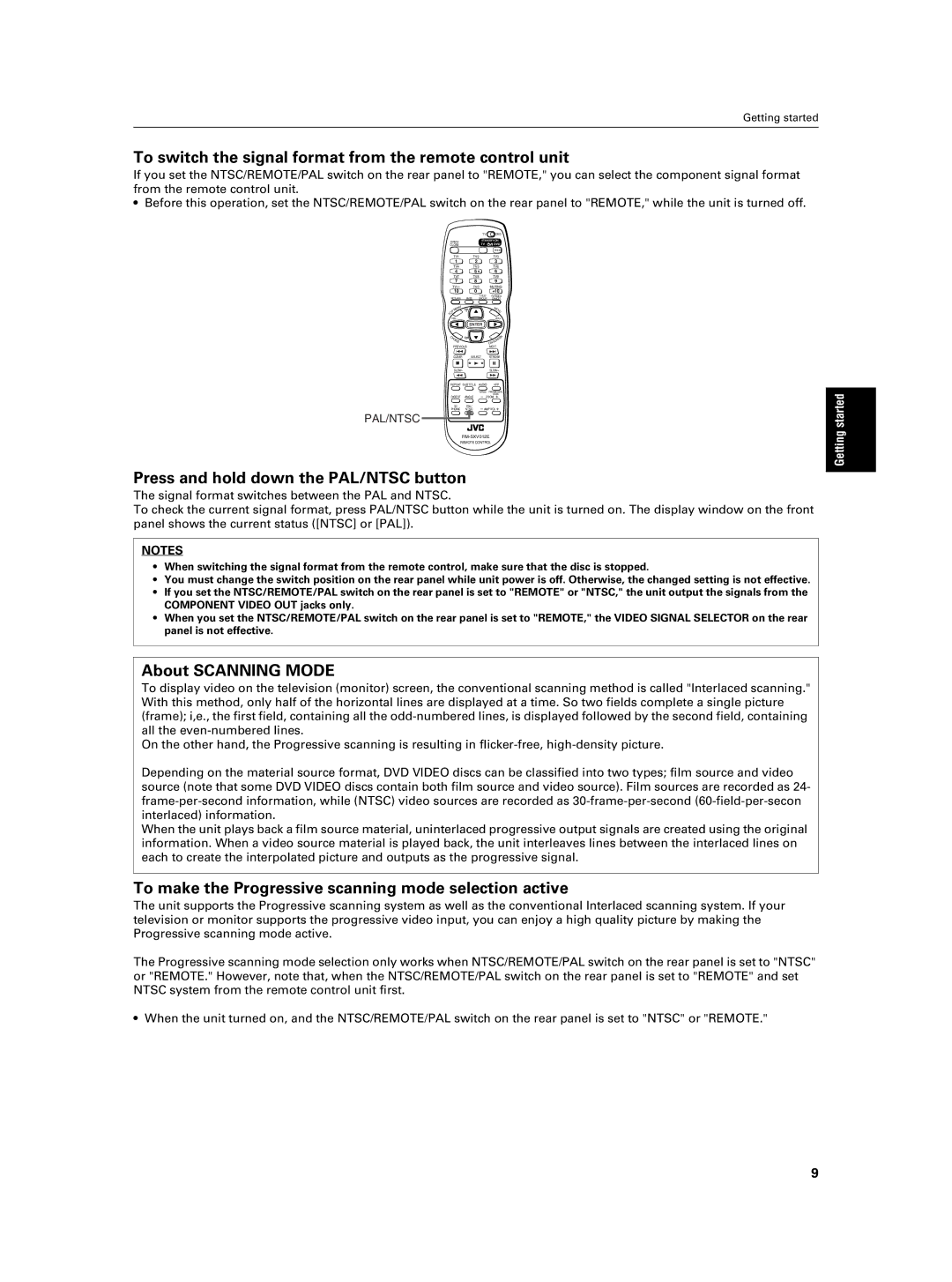
Getting started
To switch the signal format from the remote control unit
If you set the NTSC/REMOTE/PAL switch on the rear panel to "REMOTE," you can select the component signal format from the remote control unit.
• Before this operation, set the NTSC/REMOTE/PAL switch on the rear panel to "REMOTE," while the unit is turned off.
| TV | DVD |
OPEN/ | STANDBY/ON | |
CLOSE | TV | DVD |
TV1 | TV2 | TV3 | |
1 | 2 |
| 3 |
TV4 | TV5 | TV6 | |
4 | 5 |
| 6 |
TV7 | TV8 | TV9 | |
7 | 8 |
| 9 |
TV0 | MUTING | ||
10 | 0 |
| +10 |
|
| TITLE/ | TV/VIDEO |
RETURN | PAGE | GROUP | CANCEL |
U |
|
| M |
EN | CH |
| |
M |
| EN | |
P | + |
| U |
TO |
|
|
|
VOL- |
|
| VOL+ |
| ENTER |
| |
C | CH |
| EN |
H |
| ||
OI | - |
| RE |
CE |
|
| SC |
|
|
| ON |
PREVIOUS |
| NEXT | |
CLEAR | SELECT | STROBE | |
SLOW- |
|
| SLOW+ |
REPEAT SUB TITLE | AUDIO | VFP | |
|
| fs/Rate | PROGRESSIVE |
DIGEST | ANGLE |
| SCAN |
ZOOM | |||
3D | PAL/ | AMP VOL | |
PHONIC | NTSC | ||
PAL/NTSC
REMOTE CONTROL
Press and hold down the PAL/NTSC button
The signal format switches between the PAL and NTSC.
To check the current signal format, press PAL/NTSC button while the unit is turned on. The display window on the front panel shows the current status ([NTSC] or [PAL]).
NOTES
•When switching the signal format from the remote control, make sure that the disc is stopped.
•You must change the switch position on the rear panel while unit power is off. Otherwise, the changed setting is not effective.
•If you set the NTSC/REMOTE/PAL switch on the rear panel is set to "REMOTE" or "NTSC," the unit output the signals from the COMPONENT VIDEO OUT jacks only.
•When you set the NTSC/REMOTE/PAL switch on the rear panel is set to "REMOTE," the VIDEO SIGNAL SELECTOR on the rear panel is not effective.
About SCANNING MODE
To display video on the television (monitor) screen, the conventional scanning method is called "Interlaced scanning." With this method, only half of the horizontal lines are displayed at a time. So two fields complete a single picture (frame); i,e., the first field, containing all the
On the other hand, the Progressive scanning is resulting in
Depending on the material source format, DVD VIDEO discs can be classified into two types; film source and video source (note that some DVD VIDEO discs contain both film source and video source). Film sources are recorded as 24-
When the unit plays back a film source material, uninterlaced progressive output signals are created using the original information. When a video source material is played back, the unit interleaves lines between the interlaced lines on each to create the interpolated picture and outputs as the progressive signal.
To make the Progressive scanning mode selection active
The unit supports the Progressive scanning system as well as the conventional Interlaced scanning system. If your television or monitor supports the progressive video input, you can enjoy a high quality picture by making the Progressive scanning mode active.
The Progressive scanning mode selection only works when NTSC/REMOTE/PAL switch on the rear panel is set to "NTSC" or "REMOTE." However, note that, when the NTSC/REMOTE/PAL switch on the rear panel is set to "REMOTE" and set NTSC system from the remote control unit first.
• When the unit turned on, and the NTSC/REMOTE/PAL switch on the rear panel is set to "NTSC" or "REMOTE."
Getting started
9
